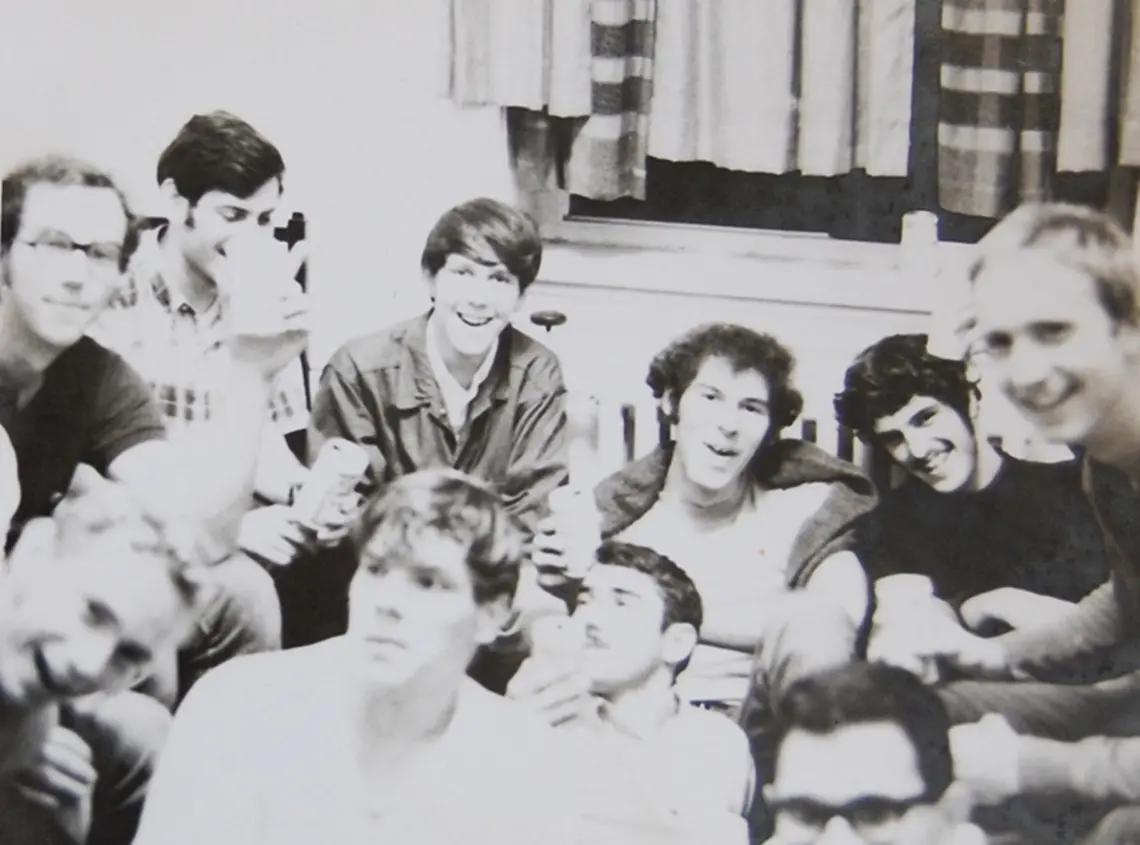


“I realized that we didn’t really have to steal the cannon — we only had to make it appear that we had stolen the cannon,” Aaron Laden ’70 told PAW, recalling the famous Princeton-Rutgers Centennial Hoax, a campus prank from September 1969. Listen to the whole story, as told by Laden, Ed Labowitz ’70, and Brian Hays ’70.
PAW Tracks is also available on iTunes — click here to subscribe
If you have a story for a future episode, email us at paw@princeton.edu.
TRANSCRIPT:
Brett Tomlinson: This episode of PAW Tracks traces its roots to freshman week in September 1966, when the director of campus security told the young men of Princeton’s Class of 1970 about notorious campus pranks, including the Oznot affair, the admission of a fictional applicant to the Class of ’68, and the Great Train Robbery, when students on horseback halted a train on the Dinky line.
Aaron Laden: The point of these stories, apparently, was to impress upon us that we should behave ourselves and not get kicked out of the University.
Ed Labowitz: I thought it was as a challenge to us, if we could think of something good like that.
BT: That’s Ed Labowitz, and before him, Aaron Laden, both from the Class of ’70. Laden took an interest in campus traditions, and in particular the cannon near the steps of Whig Hall, buried there in the 19th century to prevent Rutgers students from stealing it again. In the fall of 1969, with the 100th anniversary of the Princeton-Rutgers football rivalry approaching, Laden thought it would be a fabulous prank to swipe the cannon — but it seemed like too much work.
AL: But then, in sudden flash, I realized that we didn’t really have to steal the cannon, we only had to make it appear that we had stolen the cannon.
BT: Excited by that possibility, he called a meeting with 11 potential co-conspirators.
AL: I drew a picture of the cannon. And then I drew a picture of the hole next to it. And then the dirt on top of the cannon.
BT: Brian Hays, Class of ’70, was part of that group.
Brian Hays: It was unanimous. Everybody got it immediately.
BT: While the plan was remarkably simple, it did require some tools. Labowitz called upon a friend, a graduate student in the geology department.
EL: I said, “Can we borrow some shovels and some picks?”
BH: We needed picks.
EL: He said, “How many?” and I said, well, six or seven. And he said to me, “Do I want to know why you want these.” And I said, “You don’t want to know this.” So he didn’t know, although a couple days later, he learned what it was.
BT: The prank was planned for a Wednesday night, three days before the Rutgers game. But the group was nearly derailed while scouting out the area around midnight.
AL: We observed some figures, dressed all in black, slinking from tree to tree.
EL: As though it were one of those old cartoons — you know, a Pink Panther cartoon.
AL: And that aroused some suspicion. My recollection is that Ed approached one of these individuals and said, “Are you trying to steal the clapper?
EL: The bell clapper.
AL: At which point the response was, “The what?!”
EL: So I ran back and said these guys must be from Rutgers, because they don’t know anything about the bell clapper. I don’t know what they’re going to do. They can’t possibly steal the cannon. But we don’t want the University police to see these guys, because then they’ll be on the lookout all night and we won’t be able to pull this off.
BH: During this confusion, we still had our sentries out there. And one of the youngest, and smallest, and slightest of this crew didn’t know quite what to do, so he jumped out and said, “C’mon boys, let’s get ’em.” And what do the Rutgers guys know? So they turned tail and ran the heck off of campus.
AL: Well, we discovered that they had painted the big cannon red. And it so happened that I had a can of black paint, spray paint in my room, and so we went and repainted the cannon black.
BH: This is all happening at midnight, one in the morning, two in the morning.
BT: With the Rutgers crew headed back to New Brunswick, Hays and a handful of others got to work near the cannon by Whig Hall.
EL: We should remember that at that time, the University police and the proctors’ offices were in Stanhope Hall, so if one came out the steps at Stanhope Hall, you would be able to look right at Whig Hall. You would be able to see what was going on there, which did concern us. But we hoped that while we were doing this, they wouldn’t come out.
BH: I think we had timed the proctors’ patrols, and we had determined that the proctors were predictable in when they went by. So we knew we had a window. I don’t recall how long that window was. But we knew there was a period of time — like 30 minutes or an hour, I’ve forgotten what it was — but we had to work pretty quickly.
We had a bunch of diggers, and I was one of the diggers. And Rich Weikel [’70] was a football player, so we had some power.
BT: After more than 30 minutes of digging, the job was nearly complete.
EL: The dirt going on top of the cannon was piled five to six feet high. There was a six-foot hole there. And at that point, we all felt pretty good that we had pulled this off.
BH: Well, no — we did one more thing, which I thought was pretty clever. I don’t know who came up with it. But we did drag marks from the hole to the road, because people were going to say, “How the heck did they do that?” And so we wanted to make sure that it ended at the road, so it was implied that somebody got it onto a truck. These cannons weigh like 2,000 pounds. It would have been enormously difficult for anybody to do this. But nobody ever thought about that.
AL: Actually to lift it out of the hole would have been impossible.
BH: We needed a crane!
BT: Laden also left a note in red paint on the sidewalk. It read, “Thanks! Love, Rutgers ’72.” The scene went undetected until the following day.
EL: At around 6:00 in the morning — we’d been up all night — I went over to Stanhope Hall, to the University police, to tell them that the cannon had been stolen. That was my job. So I go to them, “Hi, I’m Ed, I’m about to do the show on WPRB. Somebody called me, knowing I do the morning show on this day, and they called me, said they were from Rutgers, told me they’d stolen the cannon. I’ve gone out there, and the cannon’s gone.”
And the policeman who was at the desk said to me, “Oh, no, no — a couple of hours ago we got a call from some Rutgers students who said they painted the cannon red.” (That’s the one in the center of Cannon Green.) “And we got out there, and the cannon isn’t red, it’s black!”
So the hoax just continued to go forward because the police did get the call. We had repainted that cannon in the center of Cannon Green black, so they were completely off the mark, thinking everything was fine. And I said, “You really ought to come outside with me. There is a cannon missing.”

BT: The officer looked into the hole and immediately called the the head of security, H. Walter Dodwell. In the 24 hours that followed, the story of the heist spread to the national press, with help from The Daily Princetonian and the University Press Club. The Associated Press reported that “a band of Rutgers University students apparently staged a pre-dawn raid.”
AL: Everybody seemed to draw the conclusions that they were predisposed to from the beginning. For example, the dean of the Rutgers engineering program was quoted as saying, “We’re glad they’re teaching those boys something.” And Mr. Dodwell was quoted as calling this a “masterful coup,” which we appreciated.
BT: Through it all, no one suspected that the cannon might still be resting in its original place. Well, almost no one.
EL: There was a dog, on Thursday in the afternoon, digging in the pile. And as recall, one of our group had to go over and chase the dog away. We were afraid the dog would blow our cover.
BH: All through the day, Thursday and Friday, at least up until Friday noon, we would wander over there and watch people looking at the hole, going, “Oh my gosh, how did they do this?”
BT: Laden was content to let nature reveal the hoax, as rain and snow gradually washed the dirt away. But the rest of the group pressed for a more dramatic unveiling.
EL: We decided that since we hadn’t actually stolen it, there couldn’t possibly be any punishment. Therefore, why not take credit for it?
BH: ABC television covered the reveal, us scraping away the dirt and showing that the cannon was there all that time.
AL: At the moment when they asked me why we did it, I said that we did it “to restore the hoax as an art form.”
EL: I have a recollection of, either later that day or Saturday morning, being out there as the grounds crew was loading the dirt back into the hole, and President Goheen was standing there, watching them do it, with this huge smile on his face.
Remember, this is the first week of coeducation, the Vietnam War was creating major issues on campuses, and was going to do that to Princeton in that ensuing year, our senior year. And here was an old-fashioned campus prank that didn’t hurt anybody, and everything was restored, and the president of the University, I suppose he was thinking, I dodged one here. I don’t have to deal with this one.
Paw in print

January 2026
Giving big with Kwanza Jones ’93 and José E. Feliciano ’94; Elizabeth Tsurkov freed; small town wonderers.



No responses yet